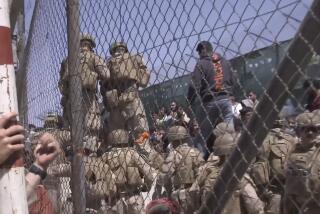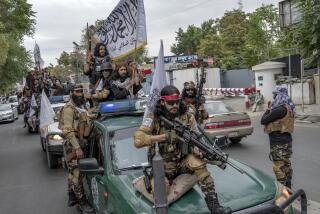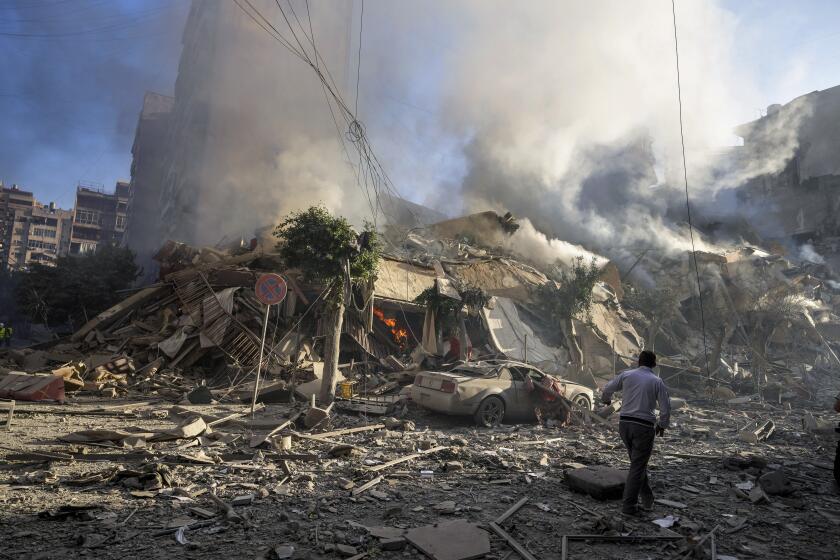Marines in Afghanistan inch forward against Taliban
Reporting from Kabul, Afghanistan, and Marja, Afghanistan -- Ambushes, sniper fire and a labyrinth of buried bombs again slowed a drive by U.S. Marines and Afghan troops Monday to rid a former Taliban stronghold of insurgents.
The arduous progress on the offensive’s third day appeared to bear out commanders’ predictions that clearing the town of Marja, in troubled Helmand province, could take weeks.
Elsewhere in southern Afghanistan, NATO reported that its troops had killed civilians in a second errant attack in as many days. A patrol of coalition forces in Kandahar province, which borders Helmand, spotted what it mistakenly thought was a group of insurgents planting bombs and called in an airstrike Monday that killed five of them and injured two others, Western military officials said.
North Atlantic Treaty Organization officials apologized for the error. U.S. military commanders have pressed troops to avoid civilian casualties that could undercut public support for the military efforts and the Afghan government.
The assault on Marja, billed as one of the largest battles of the war, is aimed at reestablishing Afghan government authority in a swath of the south where insurgents have long held sway. Securing the farming town of about 85,000 people is considered pivotal to that effort. Marja had devolved in recent years into a Taliban fiefdom rife with drug trafficking and bomb factories.
Inching their way forward Monday through dusty streets, muddy fields and walled compounds, coalition troops periodically encountered firefights. Many were what the Marines call “spray-and-pray” episodes, in which Taliban fighters fire their AK-47 assault rifles and quickly flee.
But insurgents also mounted more sustained and complex attacks. Afghan officials recounted one particularly audacious Taliban bid Sunday to overrun a position held by Marines and Afghans, in which a trio of would-be suicide bombers descended simultaneously on a newly established outpost. All were shot and killed before they could detonate their explosives, Helmand Gov. Gulab Mangal told journalists in the provincial capital, Lashkar Gah.
Improvised explosive devices, or IEDs, remained the most deadly threat. Military planners had taken the dense minefields into account; it was the main reason the assault began with troops being airlifted over the outskirts and dropped into its center. But ground forces trying to move in to link up with the airborne vanguard often found progress measured in yards rather than miles, with the misery compounded by knee-high muck.
Marines on the ground said the hidden explosive devices were both more numerous and more sophisticated than expected.
After nightfall, coalition forces repeatedly fired illumination rounds to try to track insurgents.
Some Taliban fighters are believed to have fled before the assault began, and even as the battle continued, cars carrying fighting-age men could be seen among vehicles leaving the town. About 5,000 residents have left their homes, taking refuge either in Lashkar Gah or elsewhere in the area.
Jeffrey Dressler, a military analyst with the Institute for the Study of War in Washington, said it was crucial that U.S. and Afghan forces proceed slowly to limit civilian casualties. Insurgents are hoping to blame the U.S. for civilian deaths, underscoring the need for caution.
It is also important, he said, to make sure the city is cleared of militants, and safe for civilians.
“It will take weeks to clear Marja, to really go house-to-house, road-to-road and make sure things are safe so the civilian population can actually work and have a livelihood,” Dressler said.
Advisors to U.S. Army Gen. Stanley A. McChrystal, commander of Western forces in Afghanistan, have said that U.S. forces previously cleared villages too quickly. Unlike in Iraq, where operations went on for weeks or even months, units in Afghanistan have pronounced operations completed in days.
The danger to civilians in the Helmand combat zone was underscored Sunday when NATO announced the deaths of 12 people in what it characterized as an errant rocket strike that hit a residential compound. Afghan officials said Monday that they were saddened by the incident but that it should not deter the mission’s larger aim of freeing the area from Taliban rule.
Interior Minister Mohammed Hanif Atmar told reporters a preliminary inquiry suggested that as many as three of those killed might have been insurgents who forced the family to let them into the compound.
The NATO force reiterated, however, that the compound was not the intended target. NATO’s International Security Assistance Force said Monday that the rockets had missed their mark by about 600 yards, rather than the 300 yards reported a day earlier.
McChrystal expressed regret for the “tragic loss of life” and suspended use of the rocket system involved in the strike pending investigation.
Some Marja residents did what they could to help the U.S. and Afghan forces along; others were in league with the insurgents.
One Afghan man waved down a Marine patrol to warn that a certain road was strewn with buried bombs, each marked by a rock formation by the roadside. The Marines closed the route to vehicle traffic, and after a wait of several hours, an explosive ordnance disposal team surveyed it. Only one bomb was found. The Marines concluded that the purported good Samaritan, whom they had taken for a local farmer, was actually doing what he could to slow their advance.
“We know what we have to do,” said Lance Cpl. Raymond Walker. “But who can tell the good ones from the bad ones? It’s tough.”
Times staff writer Julian E. Barnes in Washington contributed to this report.
More to Read
Sign up for Essential California
The most important California stories and recommendations in your inbox every morning.
You may occasionally receive promotional content from the Los Angeles Times.










